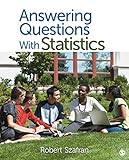Answering questions with statistics /
Published by : Sage Publications, Inc, (Thousand Oaks :) Physical details: xxv, 429 p. : ill. ; ISBN:9781412991322 (pbk.).| Item type | Current library | Collection | Call number | Status | Date due | Barcode |
|---|---|---|---|---|---|---|
 Books
Books
|
SME Library General Stacks | Non-fiction | 519.5 SZA/AN (Browse shelf(Opens below)) | Available | 15521 |
Browsing SME Library shelves, Shelving location: General Stacks, Collection: Non-fiction Close shelf browser (Hides shelf browser)

|

|

|

|

|

|

|
||
| 519.5 RAO/LI Linear Statistical Interference and its Applications | 519.5 SHA/QU Quantitative Techniques for Managerial Decisions | 519.5 SHA/ST Statistical Methods | 519.5 SZA/AN Answering questions with statistics / | 519.5 WAL/PR Practical Statistics for Geographers and Earth Scientists | 519.5 WAL/ST Statistics for Business | 519.5 WIS/QU Quantitative Methods For Decision Makers |
Machine generated contents note: Part 1. Getting StartedChapter 1. IntroductionChapter 2. Data SetsPart 2. Descriptive Statistics: Answering Questions about Your DataChapter 3. Frequency Tables and Univariate ChartsChapter 4. Central Tendency and DispersionChapter 5. Creating New VariablesChapter 6. Comparing Group MeansChapter 7. Crosstab TablesChapter 8. Nominal and Ordinal Measures of AssociationChapter 9. Pearson's Correlation and Bivariate RegressionChapter 10. Multiple RegressionPart 3. Inferential Statistics: Answering Questions about PopulationsChapter 11. Sampling Distributions and Normal DistributionsChapter 12. Hypothesis Testing and One-Sample t TestsChapter 13. Paired and Independent-Samples t TestsChapter 14. Analysis of VarianceChapter 15. Chi-SquareChapter 16. Hypothesis Testing with Measures of Association and Regression.
"The book is divided into three Parts: Part One has chapters that introduce data analysis and SPSS; Part Two contains eight chapters on descriptive statistics that begin with frequency tables and go through multiple regression; and Part Three includes six chapters on inferential statistics. Part One: Getting Started begins by answering some questions most students have right at the start © questions like why study data analysis and how much math and computer knowledge is required? Essential concepts from research methods relevant for data analysis are also explained. Part Two: Descriptive Statistics: Answering Questions about Your Data demonstrates procedures to use when the analyst is only concerned with describing the cases for which he or she actually has data. Statistics summarizing single variables (univariate statistics) are presented first and then statistics summarizing relationships between variables (multivariate statistics). Frequency tables, measures of central tendency, measures of dispersion, crosstabs, measures of association, subgroup means, and regression are all covered as are bar charts, pie charts, histograms, and clustered bar charts. Part Three: Inferential Statistics: Answering Questions about Populations explains procedures which allow the analyst to draw conclusions about the population from which his or her sample of cases was randomly selected. It begins with a simple chapter on the statistical theory behind inferential statistics. A four-step approach to hypothesis testing is introduced in the next chapter and demonstrated with one-sample t test hypotheses. The remaining chapters present different types of hypothesis tests including paired-samples, independent-samples, one and two-way ANOVA, and chi-square"--
"The book is divided into three Parts: Part One has chapters that introduce data analysis and SPSS; Part Two contains eight chapters on descriptive statistics that begin with frequency tables and go through multiple regression; and Part Three includes six chapters on inferential statistics. Part One: Getting Started begins by answering some questions most students have right at the start - questions like why study data analysis and how much math and computer knowledge is required? Essential concepts from research methods relevant for data analysis are also explained. Part Two: Descriptive Statistics: Answering Questions about Your Data demonstrates procedures to use when the analyst is only concerned with describing the cases for which he or she actually has data. Statistics summarizing single variables (univariate statistics) are presented first and then statistics summarizing relationships between variables (multivariate statistics). Frequency tables, measures of central tendency, measures of dispersion, crosstabs, measures of association, subgroup means, and regression are all covered as are bar charts, pie charts, histograms, and clustered bar charts. Part Three: Inferential Statistics: Answering Questions about Populations explains procedures which allow the analyst to draw conclusions about the population from which his or her sample of cases was randomly selected. It begins with a simple chapter on the statistical theory behind inferential statistics. A four-step approach to hypothesis testing is introduced in the next chapter and demonstrated with one-sample t test hypotheses. The remaining chapters present different types of hypothesis tests including paired-samples, independent-samples, one and two-way ANOVA, and chi-square"--


There are no comments on this title.